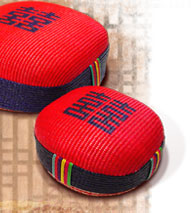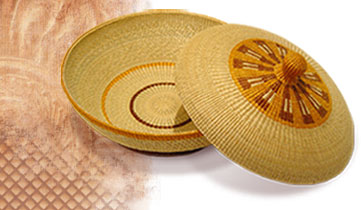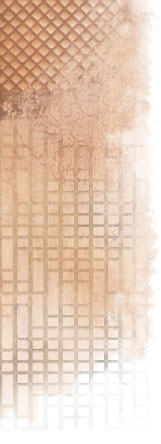| An ordinary, nondescript plant growing in
the rice paddies and marshlands of Korea, often cast aside, is transformed into an exquisite art form, a work of beauty so fine it seems unbelievable that it was made by human hands. Wancho basketry is the result not only of years of training by the craftsman, but also of incredible patience and dexterity. To be able to harness nature into such harmonious, delicate detail is not an ordinary gift ─ it is to be blessed with a mastery that can only be considered extraordinary. In Korea, there is a person who is designated by the government to make various traditionally-woven household objects such as mats and containers. He is otherwise known as the honorable Wancho Jang, or Master Craftsman of Wancho Weaving. Wancho is an annual reed commonly found in rice paddies or other marshlands in some parts of Korea, and can reach a height of up to two meters when fully grown. In Korea, the plant is called by many different names including wanggol, yong sucho, hyeonwan, or seong nyeongchu. Wancho is characterized by its sleek texture, milky-white color and soft but durable body, which makes it an excellent material for craft weaving. Wancho wares, such as floor mats, are ideal for use in the summer because they are lightweight and maintain Kingdoms” (57 B.C.-668 A.D., the period when the three ancient Korean kingdoms, Koguryo, Baekje and Silla, rivaled each other), Korea’s earliest remaining history book; the book relates how the people of Silla used wancho goods during that era. It is also known that during the following Goryeo period(918-1392), wancho mats were laid under the ancestry tablets of Hutossi and Hujikssi, the guardian deities of land and grain. These mats, such as munseok (character-motif mat), chaeseok (color-patterned mat) and hwamun daeseok (large mat with floral motif), were favored by the royal households of Goryeo, and some were even sent to the Chinese court as special gifts. The history of wancho weaving is nearly as diverse as the kinds of wancho products made. In fact, Buddhist monks from Hwagaesa Temple in Kanghwa Island during the Goryeo period created the first hwabangseok mat by weaving Wancho reeds thriving in the wetlands into mats to sit on during prayer services. According to the “Annals of the Joseon Dynasty” (1392-1910), or “Joseon Wangjo Sillok,” wancho products were considered to be the most desired items by the Joseon society. In fact, it states evil government officials forced locals to offer wancho goods, under the pretext of a tribute, to royal households. In the Joseon period, the types of wancho items, especially mats, were quite diverse and were called by different names according to their shapes, colors and patterns. However, the most popular designs of the time were flowers and auspicious animals such as dragons. Wancho baskets were originally used for keeping food, needlework or other small household items. During the Joseon period, a single-piece basket was commonly used, although today Koreans prefer to use a triplepiece set. The patterns became much refined and diverse through time, and now geometrical figures (particularly those of the Buddhist symbols), flowers, the taegeuk (yin-yang symbol), and bong hwang (Korean phoenix) are popular. Today wancho baskets are used as jewel cases, decorative pieces for the home, or as receptacles for special occasions such as memorial services. Whatever their use, their artistic value is highly admired and treasured. View the master's works |
||||||||||
|

















